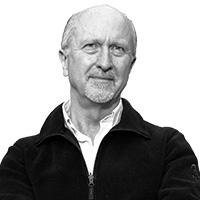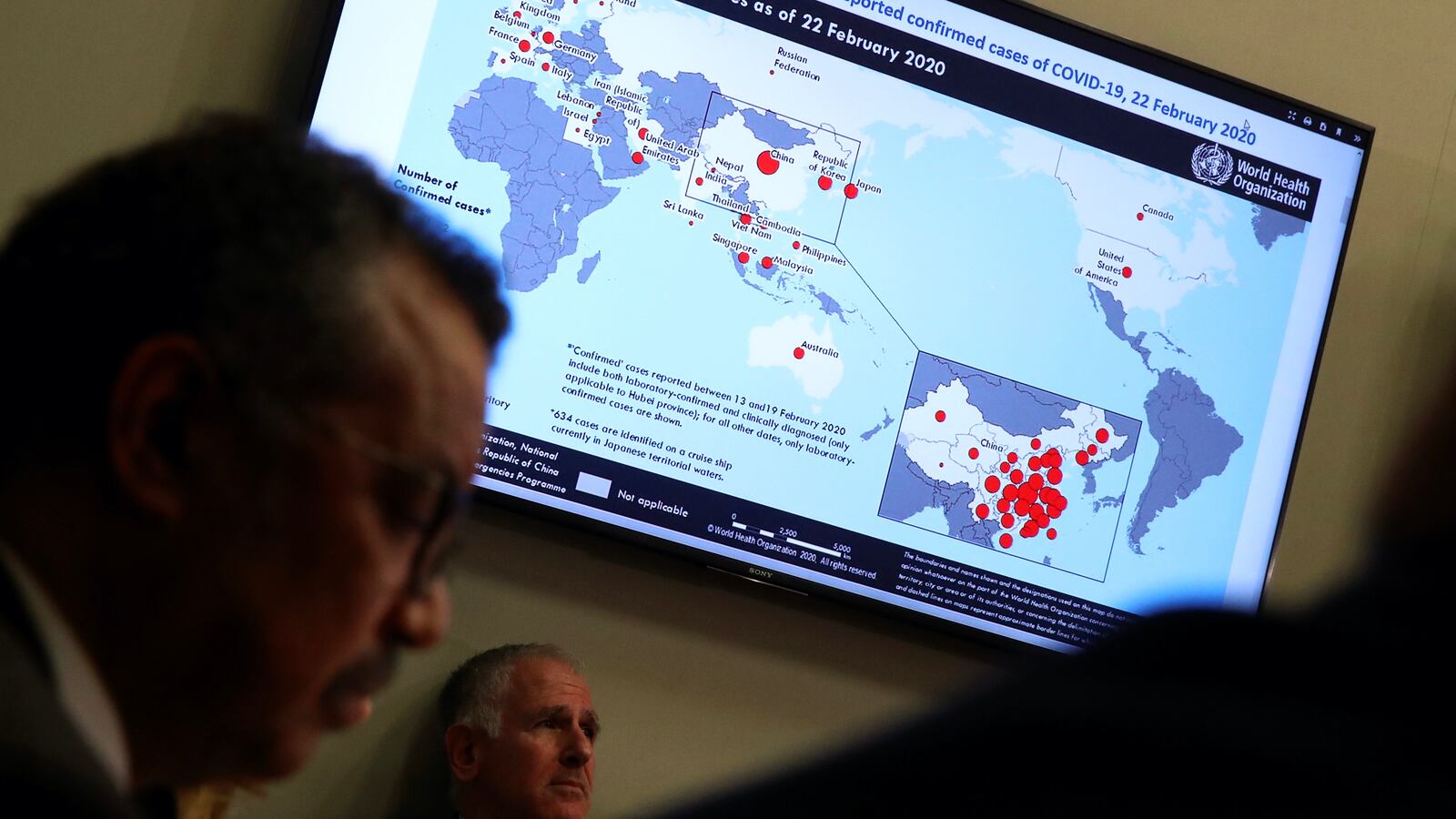PARIS—Finally the question came. Forty-five minutes into a Zoom press conference with top figures of the World Health Organization (WHO) on Wednesday afternoon, a Spanish journalist asked them flat out to defend their organization against charges leveled by President Donald Trump.
The day before, during Trump’s Five O’Clock Follies at the White House, he’d blamed the WHO for, in essence, covering China’s ass in January as Beijing lied about how contagious the newly identified coronavirus in the city of Wuhan really was.
In a now-infamous Jan. 14 tweet, the WHO declared “Preliminary investigations conducted by the Chinese authorities have found no clear evidence of human-to-human transmission of the novel #coronavirus (2019-nCoV) identified in #Wuhan #China.”
We now know that, bureaucratic copouts like "no clear evidence" notwithstanding, the tweet was grossly misleading, and it has become Exhibit Number 1 in the Trump-led rants against the WHO.
In fact, Chinese authorities were pretty sure by Jan. 14 that people could contract the disease from other people. Top officials at the WHO were aware of that, too. Indeed, one of them said publicly at a Jan. 14 press conference, the same day the tweet went out, that there was “limited” evidence of human transmission and risk of a “super-spreading” event.
Trump said Tuesday he’d ordered a suspension of U.S. funding for the WHO pending an investigation. Trump claims that if only the WHO had nailed the Chinese for obscuring the real threat of the virus early on, the world wouldn’t be in the mess it’s in right now and many lives could have been saved. The WHO, Trump said last week, is “China-centric.” (Conveniently forgotten at his presentations: the 70 days Trump spent trying to wish away the coming pandemic as well as his early praise for China’s "efforts and transparency.")
In fact, the WHO’s director general for 10 years was Chinese, and its current head is an Ethiopian, Tedros Adhanom Ghebreyesus, said to be favored by Beijing.
As a report from the liberal think tank Center for American Progress noted last year, China has carried out a conscious long-term policy of building influence in international organizations, a task made much easier by the Trump administration’s lack of interest or open hostility toward the United Nations. The U.S. is the WHO’s biggest donor, but it has not bothered to appoint anyone to sit on the organization’s board since 2018. If you walk off the field, it’s not surprising that others will dominate the game. And if you are a WHO bureaucrat, it’s not exactly amazing that you’d defer diplomatically to the sensibilities of the dominant force in your organization.
In opening remarks Wednesday, Tedros was defensive without answering any specific accusations. “We regret the decision of the president of the United States to order a halt in funding to the World Health Organization,” he said, emphasizing its work fighting not only COVID-19 but many other diseases. “Our commitment to public health, science, and to serving all the people of the world without fear or favor remains absolute,” said Tedros. “Our mission and mandate are to work with all nations equally, without regard to the size of their populations or economies.”
(He left it to a speaker from the organization’s legal department to explain why the WHO has distanced itself from Taiwan, which has long enjoyed observer status, but is one of Beijing’s bêtes noires.)
The WHO director general took some solace in the solidarity shown by other nations and individuals. Bill Gates, whose Bill and Melinda Gates Foundation has contributed millions of dollars to the WHO, declared that halting U.S. government funding “is as dangerous as it sounds.” No other organization can replace it, and the world needs the WHO “now more than ever.”
But Tedros and his associates refused to give any specific idea how they would manage a shortfall if Trump succeeds in cutting hundreds of millions of dollars from the budget.
There followed a number of deferential questions from the regular WHO press corps. (The Daily Beast was not called on.) And then, finally, that blunt one from the Spanish press agency EFE: “So, the main accusations from the U.S. president to WHO are that the organization failed to confirm in the first weeks of January that there was human-to-human transmissions, and also that it opposed flight restrictions from China to the U.S. and other countries. What has WHO to say in its defense?”
Michael J. Ryan, head of the organization’s health emergencies program, was the first to respond. At first it seemed the ruddy-faced Irishman was on the brink of prevarication, suggesting there would as always be a post-pandemic investigation of the WHO’s performance. But then something appeared to click inside his head and he launched into a full-blown explanation of the way his organization addressed the crisis in its early stages.
“We alerted the world on January 5,” said Ryan. Institutions responsible for fighting such diseases, including in the U.S., were made aware of the mysterious outbreak in Wuhan and began organizing the next day. But the precise nature of the disease was yet to be determined, he said.
“Through the next number of weeks we produced multiple updates including briefing multiple governments, multiple scientists around the world on the developing situation—and that is what it was, a developing situation,” said Ryan. “The virus was identified on Jan. 7, the sequences were shared on the 12th with the world”—sequences being the genetic map of the virus, vital to diagnosis, development of a vaccine, and other therapies.
“We were dealing with a completely new virus,” Ryan noted, which was why in the initial reports “there were no mentions of human to human transmission.” Instead, what was described was “a cluster of atypical pneumonia or pneumonia of unknown origin.” But “there are literally millions and millions of cases of atypical pneumonia around the world every year,” said Ryan. “And in the middle of an influenza season, sometimes it is very difficult to pick out a signal of a cluster of cases. In fact, it is quite remarkable that such a cluster was picked out, 41 confirmed cases ultimately in a cluster in Wuhan.”
“There is always a risk with a respiratory pathogen that it can move from person to person,” Ryan continued, “... and when the WHO issued its first guidance to countries, it was extremely clear that respiratory precautions should be taken in dealing with patients with this disease, that labs needed to be careful in terms of precautions in taking samples, because there was a risk that the disease could spread from person to person in those environments.”
Past experience with the coronavirus known as Middle East Respiratory Syndrome and the avian flu virus H5N1 showed they can spread from person to person in families, in some job settings, and in hospitals, but tend not to infect the wider community. “The determination was not whether or not human-to-human transmission was occurring, the determination was: was the virus spreading efficiently at community level outside those environments? And that is not an easy determination to make, and one has to make that very carefully.”
Unfortunately, erring on the side of caution also meant erring on the side of obfuscation.
Maria van Kerkhove, the American epidemiologist who is leading the technical side of the WHO’s COVID-19 operations, said she had looked back at the organization’s Jan. 14 press conference (the first she ever gave) where she had even raised the possibility there could be human “super spreaders” of the disease. But the emphasis was on the unknowns.
“At the time there were 41 confirmed cases,” she said. “We needed to know what disease it causes and how to care for people, we needed to know the mode of transmission, including if there is any human-to-human transmission, what is the extent of the transmission, we needed to know how to limit exposure and what to do, what is the extent of infection. And so all of our guidance that was out before we did that press conference was about limiting exposure to people and to prevent transmission, particularly in health-care settings.”
As for banning flights (a point Trump emphasizes because his ban on travel from China was the only serious measure he was willing to take early on), the WHO maintains that this is a choice entirely up to national governments, and in point of fact the organization has no power to dictate such actions.
Unfortunately, despite the help China gave with the identification of the virus and the sequencing of the genome, in January it was trying hard to cover up what some officials there knew could be a pandemic in the making. Doctors who discussed the threat in a professional chat room in December were silenced. And it is clear from a report by the WHO that came out on that same fateful day as the tweet, Jan. 14, that while Beijing was withholding information, the WHO was powerless to do much about it.
A Chinese woman in Thailand who had been in Wuhan was recorded as the first exported case of the disease, and she had never gone to the market that Chinese officials had tried to blame as the sole source of it. Worse still, the WHO repeated what we now know to be blatant lies by the Chinese government: “To date, China has not reported any cases of infection among health-care workers or contacts of the cases.”
In fact, many were infected and on Feb. 7, Dr. Li Wenliang, one of the young whistleblowers who’d initially been silenced, died of COVID-19.
The WHO listed the many unknowns, which might have suggested to those reading between the lines that WHO personnel had some reservations, but the takeaway from the Jan. 14 report was worse than the infamous Jan. 14 tweet: “Based on the available information there is no clear evidence of human-to-human transmission,” the WHO said. And even more stunning in retrospect, it reported, “No additional cases have been detected since 3 January 2020 in China.” That was what Beijing had said.
We now know that officials in Wuhan, willful in their ignorance, staged as usual a huge annual banquet for 40,000 families on Jan. 18. And by the time Dr. Li died three weeks later, China admitted to 31,000 cases amid a draconian lockdown. The first novel coronavirus cases were identified in South Korea and in the United States on Jan. 20. But Trump said the situation was under control, and thanked China for its “transparency.” On Jan. 30, the WHO declared a global health emergency. On Jan. 31, Trump barred most travelers coming from China. But on Feb. 9, Trump suggested the seasonal flu was more dangerous than COVID-19, there were only 15 cases in the United States, and soon there would be zero.
The rest is the history we are living.






